Anti-Vegf Therapy
The FDA approval of anti-VEGF therapy for the treatment of exudative ARMD has heralded a new era for the management of this devastating disease, offering patients and their families true hope for the maintenance of useful vision throughout their life. Currently, there are two FDA-approved anti-VEGF drugs available for intravitreal injection, and more are undergoing clinical trials. While a class of medications serving as antagonists to an “angiogenic factor” with a goal of treating disease was first proposed in The New England Journal of Medicine in 1971,23 the year 2004 officially ushered in the era of intravitreal medications targeting VEGF.24 Pegaptanib (Macugen; Eyetech Pharmaceuticals) was the first FDA-approved anti-VEGF medication for wet ARMD. This was shortly followed by the introduction of off-label use of bevacizumab (Avastin; Genentech)25 and the approval of ranibizumab (Lucentis; Genentech).26
Pegaptanib
Pegaptanib is a 28-base ribonucleic acid aptamer, or an RNA ligand with high affinity for VEGF, that is covalently linked to two branched 20-kD polyethylene glycol moieties that primarily targets one isoform of VEGF (VEGF-165).27 This drug is the product of a sugar structure with glycol additions to increase its half-life in the vitreous.28 The VEGF Inhibition Study in Ocular Neovascularization (VISION) trials demonstrated that pegaptanib stabilized visual acuity in patients with wet ARMD, as compared to sham injection.27,29,30 The injections were performed every 6 weeks in patients with any of the angiographic subtypes (classic, minimally classic, occult) of wet ARMD. Pegaptanib reduced the chance of loss of 15 letters (3 lines on the study chart) (Fig. 10.1), in addition to reducing the chance of severe visual loss (more than 30 letters, or 6 lines, on the study chart).27 At the conclusion of 2 years of treatment in the VISION trials, ten percent of pegaptanib-treated patients gained at least three lines of vision (Fig. 10.2). This was greater than with only 1 year of treatment with pegaptanib or with usual care.29 The benefit of the treatment appeared to be regardless of size or angiographic type of wet ARMD neovascularization, in contrast to older modalities of treatment.
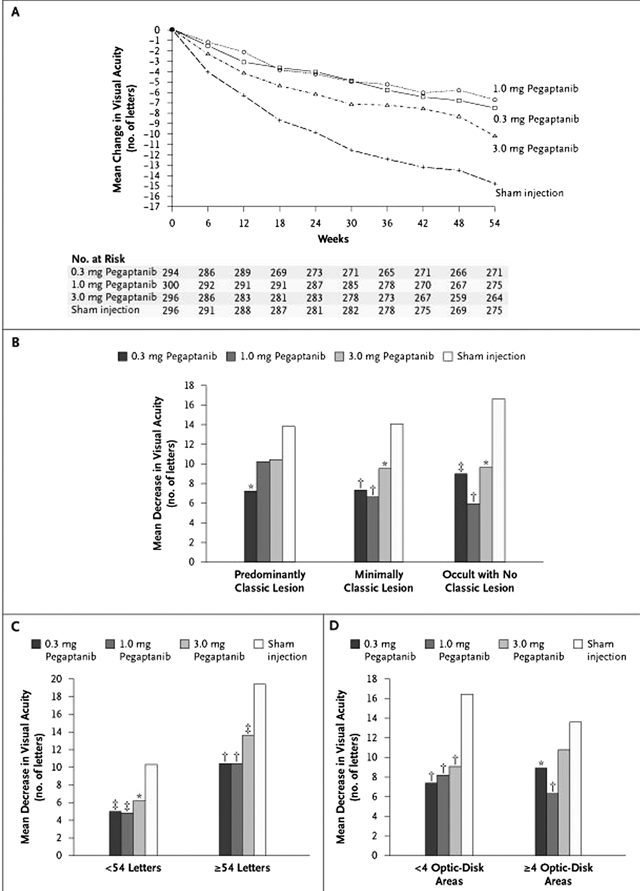
FIGURE 10.1. Mean change in scores for visual acuity. Panel A shows the mean changes in visual acuity from baseline to week 54 (p < 0.002 at every point for the comparison of 0.3 or 1.0 mg of pegaptanib with sham injection at week 54, and p < 0.05 at every point for the comparison of 3.0 mg of pegaptanib with sham injection at all other points after baseline). Panels B, C, and D show the mean changes in visual acuity according to the angiographic subtype, visual acuity, and lesion size at baseline, respectively. In relation to the visualization of choroidal new vessels (classic) in the fluorescein angiogram, a predominantly classic lesion includes 50% or more classic CNV, a minimally classic lesion includes <50% classic CNV, and an occult lesion includes no classic CNV. For lesion size, the unit of measurement was one optic-disc area, equal to 2.54 mm2. For this analysis, lesions were categorized as less than four optic disc areas or four or more optic disc areas in size. In Panels B, C, and D, the *denotes p < 0.05 for the comparison of pegaptanib with sham injection, †p < 0.001 for the comparison of pegaptanib with sham injection, and the ‡p < 0.01 for the comparison of pegaptanib with sham injection. Of a total of 1,186 patients, 294 received 0.3 mg of pegaptanib, 300 received 1.0 mg of pegaptanib, 296 received 3.0 mg pegaptanib, and 296 received sham injection. (Reprinted from Gragoudas, et al. Pegaptanib for neovascular age-related macular degeneration. N Engl J Med. 2004; 351:2805–2816, with permission.)
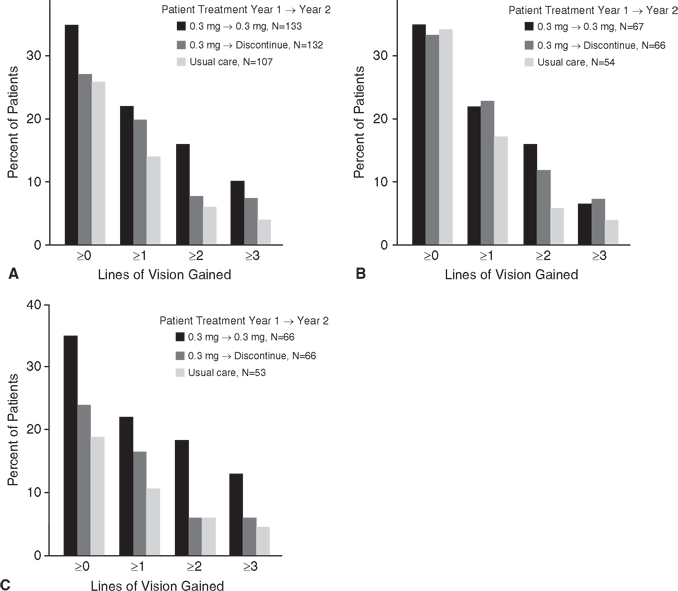
FIGURE 10.2. Vision gain. A: Studies 1003 and 1004 combined. B: Study 1003. C: Study 1004. (Reprinted from VEGF Inhibition Study in Ocular Neovascularization (V.I.S.I.O.N.) Clinical Trial Group. Ophthalmology. 2006;113:1508e.1–1508e.25, with permission.)
Bevacizumab
While approval of pegaptanib for all forms of wet ARMD began the anti-VEGF revolution, the introduction of other intravitreal medications has offered additional, more promising options for patients with wet macular degeneration. In the summer of 2005, reports of improvement in wet ARMD with intravitreal administration of bevacizumab, an FDA-approved treatment for metastatic colon cancer, appeared in the medical literature.31 This treatment arose between the introduction of pegaptanib and the FDA approval of ranibizumab for treatment of wet ARMD. While it is closely related to ranibizumab in its structure and function, differences in size, design, and cost do exist. Both bevacizumab and ranibizumab bind all biologically active forms of VEGF-A, whereas pegaptanib binds only 165 kD and, possibly, larger forms of VEGF-A.27,32 Bevacizumab is a humanized monoclonal antibody against VEGF. It is larger than ranibizumab, which is an antigen-binding fragment against VEGF. One of the appealing qualities of bevacizumab is its price, which has partially led to its widespread adoption for off-label treatment of wet ARMD.33 A large portion of the pricing of the drug for cancer resides in the extensive cost related to the clinical trials necessary for FDA approval for cancer therapy; intravitreal doses are a portion of the cancer dose, so the intravitreal cost is dramatically less.
While price plays a role in bevacizumab’s widespread use for wet ARMD therapy, numerous reports, small series, and small trials have demonstrated significant efficacy, suggesting similar results to those of ranibizumab.34–36 However, it remains an off-label treatment. At the time of this publication, there is at least one large-scale clinical trial looking at the efficacy of bevacizumab in comparison to the FDA-approved ranibizumab, the Comparison of Age-Related Macular Degeneration Treatments Trial (CATT trial), which will be discussed in greater detail below. Of the completed randomized controlled trials for bevacizumab to date, all showed that bevacizumab is more effective than PDT. While these trials demonstrated an overall lack of masking, the results still show efficacy of bevacizumab.34,35–36 Some reports include patients receiving systemic (intravenous) bevacizumab, which currently is much less common than intravitreal injection as a treatment for ARMD.33,37 The adverse events reported in a recent meta-analysis of intravitreal bevacizumab consisted of postinjection inflammation, rare cases of endophthalmitis, pigment epithelial tears, submacular hemorrhage, cataract progression, and few systemic events, the majority of which were common to patients with advanced age or other cardiovascular risk factors.33 Specific concern should be paid to arterial thromboembolic events since the data in ANCHOR,46 discussed below, seemed to show a trend, though not statistically significant, of arterial thromboembolic events in the higher 0.5-mg ranibizumab dose cohort. These risks appear to be of approximately equal occurrences in the treatment versus nontreatment groups in a majority of studies listed above.
Of the trials for bevacizumab in wet ARMD analyzed in a recent review of the literature, the bevacizumab treatment arms demonstrated mean visual change of +8.6 ETDRS letters, and central retinal thickness decreased by a mean of 90 μm over a study population of 1,396 patients.33 Three randomized controlled trials within this meta-analysis demonstrated that bevacizumab was superior to PDT, either with or without intravitreal triamcinolone.33 While it is difficult to compare study results unless the study designs are identical, comparison is necessary to obtain an overall understanding of potential treatment benefits and pitfalls. The bevacizumab results in the literature appear to be of similar magnitude to those obtained with ranibizumab in the pivotal studies that will be discussed later.36–38
The standard of care, prior to the launch of anti-VEGF therapy, was PDT with verteporfin. Bevacizumab 2.5 mg has been compared to PDT for the treatment of predominantly classic wet ARMD in a randomized, prospective trial. This study found that all 32 eyes (100%) receiving bevacizumab lost <15 letters in visual acuity when compared with eyes that received PDT (73.3% lost <15 letters) at the 6-month endpoint (p = 0.002).34 Recently, several small studies have indicated that there could be synergism between either pegaptanib or bevacizumab, in combination with PDT for the treatment of wet ARMD.41–44 One such study demonstrated stability of lesions over 12 weeks with combination of PDT and bevacizumab treatment. This also correlated with improved or stabilized visual acuity. At the 24-week visit, 7 of the 11 treated eyes showed CNV leakage on fluorescein and were retreated with the combination therapy. It is important to note that these patients had CNV progression, despite PDT, prior to the study onset. It is reasonable to conclude that, in this small study, the combination of PDT and bevacizumab could possibly reduce the number of re-treatments and provide better visual acuity than would be provided by PDT alone.41 Currently, the goal to reduce intervention frequency is driving combination trials of two or more therapies, ranibizumab or pegaptanib + PDT ± triamcinolone ± vitrectomy, attempting to decrease treatment burden of regular intravitreal injections.45 This drive to reduce intervention frequency has also led clinicians to reduce the frequency of intravitreal injections, which is discussed further in the discussion of ranibizumab therapy below.
Ranibizumab
The most impressive results thus far in the anti-VEGF revolution have been provided in pivotal trials of the humanized monoclonal antibody fragment, ranibizumab. A new era in the treatment of exudative ARMD began with the release of the first phase 3 data evaluating ranibizumab (Miller, ASRS abstract, Montreal, 2005). Indeed, this single drug has revolutionized the concept of stabilizing and, in many cases, improving vision in wet ARMD. Ranibizumab is FDA approved for treatment of all angiographic subtypes of wet ARMD.25 The pivotal phase 3 clinical trials, MARINA and ANCHOR, provide the evidence that led to ranibizumab being the first FDA-approved agent that truly prevents vision loss and significantly improves vision in many patients with wet ARMD.40,46 Further studies, such as PrONTO and PIER, were aimed at determining less-frequent ranibizumab dosing regimens, since the prior studies utilized monthly injections.39,47 The SAILOR trial was designed to evaluate the safety of two doses of intravitreal ranibizumab.45 All of these will be discussed below, followed by a brief report on newer anti-VEGF drugs that are in development or clinical trials.
MARINA Trial
The Minimally Classic/Occult Trial of the Anti-VEGF Antibody Ranibizumab in the Treatment of Neovascular Age-Related Macular Degeneration (MARINA) was a 2-year, prospective, randomized, double-masked, sham-controlled study that evaluated the safety and efficacy of ranibizumab versus control in the treatment of minimally classic or occult CNV.40 Intravitreal injection of 0.3 mg ranibizumab, 0.5 mg ranibizumab, or sham was administered once a month, for a total of 24 injections over 2-year period of the study. At both time-points of 12 and 24 months, 90% to 95% of the patients who were treated with one of the ranibizumab doses lost <15 letters (ETDRS) visual acuity. This was compared to 53% to 64% of the controls (sham). With regard to vision gains, 25% to 34% of the patients treated with ranibizumab gained 15 letters or more of visual acuity. Only 4% to 5% of the control patients achieved a 15-letter gain (p < 0.001) (Fig. 10.3). Serious ocular adverse events were uncommon and included uveitis (1.3%) and endophthalmitis (1%) (Box 10.2).40
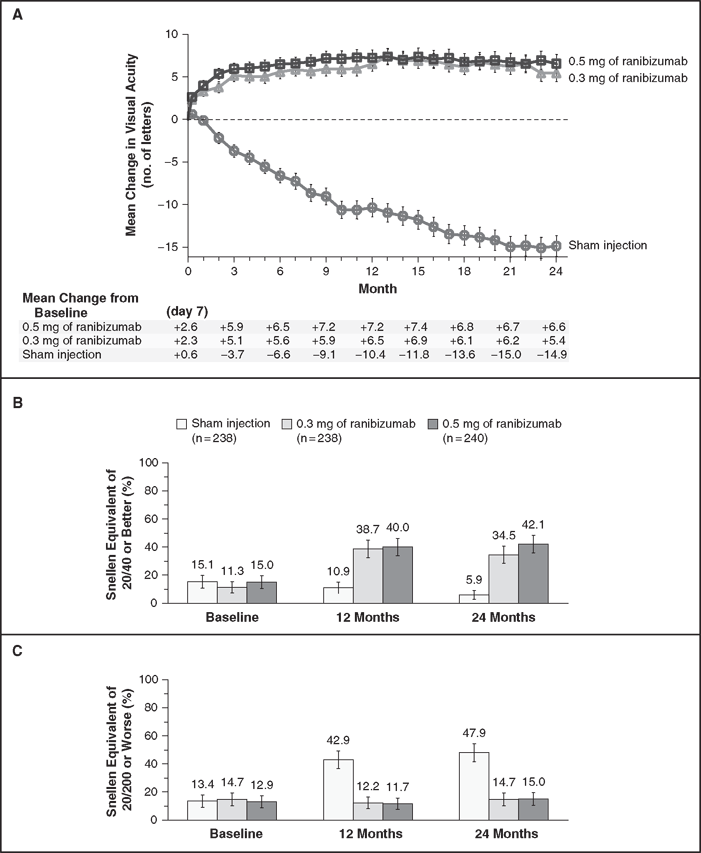
FIGURE 10.3. Mean changes from baseline in visual acuity and Snellen equivalents at 12 and 24 months. Panel A shows the mean changes from baseline in visual acuity during a 24-month period. At each monthly assessment, p < 0.001 for the comparison between each ranibizumab group and the sham-injection group. On day 7, p = 0.006 for patients receiving 0.3 mg of ranibizumab and p = 0.003 for those receiving 0.5 mg. Panels B and C show the change from baseline in the percentage of patients with a Snellen equivalent of 20/40 or better and the percentage of patients with 20/200 or worse, respectively, at 12 and 24 months (p < 0.001 for the comparison between each ranibizumab group and the sham-injection group at 12 and 24 months). Treatment comparisons use pair-wise models adjusted for visual acuity scores at day 0 (<55 letters vs. ≥55 letters) and for the type of CNV. Analysis of variance was used to assess the change in visual acuity from baseline at each monthly assessment. The Cochran χ2 test was used for the comparison of percentages. The last-observation-carried-forward method was used to handle missing data. All statistical tests were two-sided. I bars represent SE in Panel A and 95% confidence intervals in Panels B and C. (Reprinted from Rosenfeld, et al, MARINA Study Group. N Engl J Med. 2006;355:1426, with permission.)
BOX 10.2 MARINA Trial: Minimally Classic/Occult Trial Of The Anti-VEGF Antibody Ranibizumab In The Treatment Of Neovascular ARMD
- Purpose: To compare efficacy of Ranibizumab versus sham injections in neovascular ARMD.
- Methods: In a multicenter, 2-year, double-blind, randomized, sham-controlled study, macular degeneration patients (716) with either minimally classic or occult CNV received 24 monthly intravitreal injections of ranibizumab (either 0.3 or 0.5 mg) or sham injections. The primary end point was the proportion of patients losing fewer than 15 letters from baseline visual acuity at 12 months.
- Results: At 12 months, 94% patients treated with ranibizumab lost fewer than 15 letters, as compared with 62.2% of patients receiving sham injections. Visual acuity improved by 15 or more letters in 24% to 33% patients treated with ranbizumab as compared with 5.0% of the sham-injection group. The benefit in visual acuity was maintained at 24 months. During 24 months, presumed endophthalmitis was identified in five patients (1.0%) and serious uveitis in six patients (1.3%) given ranibizumab.
- Conclusions: Intravitreal administration of ranibizumab for 2 years prevented vision loss and improved mean visual acuity, with low rates of serious adverse events. (Reprinted with permission from Rosenfeld PJ, Brown DM, Heier JS, et al, MARINA Study Group. Ranibizumab for neovascular age-related macular degeneration. N Engl J Med. 2006; 355:1419–1431.).
ANCHOR Trial
The Anti-VEGF Antibody for the Treatment of Predominantly Classic Choroidal Neovascularization in Age-Related Macular Degeneration (ANCHOR) trial was the second pivotal, 2-year, prospective, randomized, double-masked, sham-controlled study in which treatment with ranibizumab was performed, and it was compared to treatment with PDT (photodynamic therapy with verteporfin).46 Again, subjects were randomized to receive monthly intravitreal injections of 0.3 mg ranibizumab or 0.5 mg ranibizumab for 2 years. The control in this study was PDT every 3 months, as needed, according to the accepted, standardized guidelines. The findings were, again, similar to those presented in MARINA. Ninety to ninety-six percent of the ranibizumab-treated patients lost <15 letters of visual acuity at 12 and 24 months. This was compared to the control, PDT, in which 64% to 66% of the treated patients lost <15 letters of visual acuity. Regarding gains in vision, 34% to 41% of the ranibizumab-treated patients gained more than 15 letters versus approximately 6% of the PDT-treated patients46 (Figs. 10.4 and 10.5). One important note from ANCHOR is in regard to safety. Arterial thromboembolic events, defined in the study as nonfatal myocardial infarction, nonfatal ischemic stroke, hemorrhagic stroke, or death due to vascular or unknown causes, were noted to be slightly higher in number in the 0.5-mg ranibizumab treatment group.46 While this was not statistically significant, and it has not been duplicated in many studies following ANCHOR, many clinicians prefer not to treat with intravitreal anti-VEGF agents if a patient has had a recent stroke or heart attack (within 3–12 months of the injection) (Box 10.3).
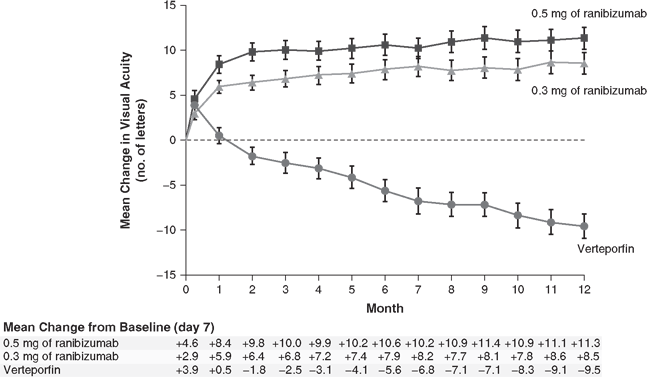
FIGURE 10.4. Mean (±SE) changes in the number of letters read as a measure of visual acuity from baseline through 12 months. p < 0.001 for all monthly comparisons of each dose of ranibizumab with verteporfin. Pair-wise analysis of variance adjusting for the visual-acuity score on day 0 (<45 letters vs. ≥45 letters) was used to analyze the mean change in visual acuity from baseline at each monthly assessment. The last-observation-carried-forward method was used to impute missing data. All statistical tests were two-sided. (Reprinted from Brown, et al. N Engl J Med. 2006;355:1438, with permission.)
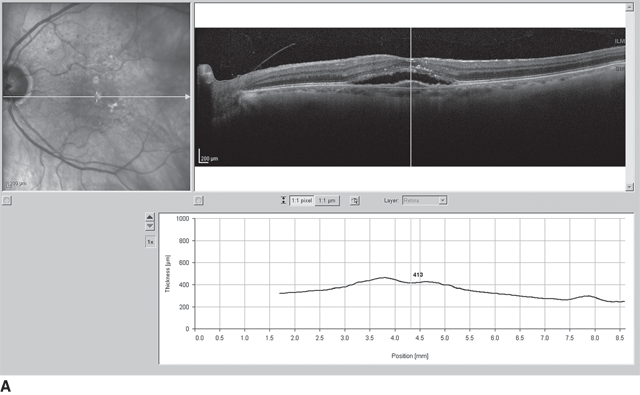
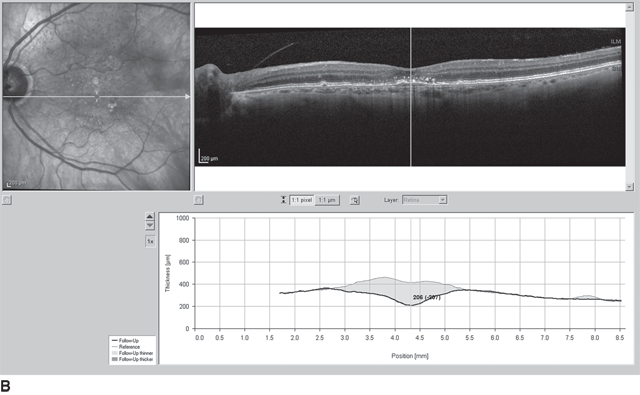
FIGURE 10.5. OCT pictures of wet ARMD. A: Before treatment with ranibizumab. B: After treatment with ranibizumab.
BOX 10.3 ANCHOR Trial: ANti-VEGF Antibody for the Treatment of Predominantly Classic CHORoidal Neovascularization in ARMD
- Purpose: To compare ranibizumab with PDT with verteporfin in the treatment of predominantly classic neovascular ARMD.
- Methods: In a 2-year, multicenter, randomized, double-blind study, patients (423) in a 1:1:1 ratio received monthly intravitreal injections of ranibizumab (0.3 or 0.5 mg) plus sham verteporfin therapy or monthly sham injections plus active verteporfin therapy. The primary end point was the proportion of patients losing fewer than 15 letters from baseline visual acuity at 12 months.
- Results: About 94% to 96% patients lost fewer than 15 letters, as compared with 64.3% of those in the verteporfin group. Visual acuity improved by 15 letters or more in about 35% to 40% patients treated with ranibizumab as compared with 5.6% of the verteporfin group. Among 140 patients treated with 0.5 mg of ranibizumab, presumed endophthalmitis occurred in two patients (1.4%) and serious uveitis in 1 (0.7%).
- Conclusions: Intravitreal Ranibizumab was superior to verteporfin with low rates of serious ocular adverse events. (Reprinted with permission from Brown DM, Kaiser PK, Michels M, et al. Ranibizumab versus verteporfin for neovascular age-related macular degeneration. N Engl J Med. 2006;355:1432–1444.)
FOCUS Trial
The RhuFab V2 Ocular Treatment Combining the Use of Visudyne to Evaluate Safety (FOCUS) trial had similar results to the above-mentioned ANCHOR trial.48,49 This was a prospective, randomized, single-masked, phase 1/2 study that compared stand-alone PDT to ranibizumab plus PDT. PDT was performed on all patients upon entry to the study. Then, they were given monthly sham injections or monthly 0.5-mg ranibizumab for 2 years. PDT could be repeated every 3 months, as needed, according to the previously mentioned, accepted, standardized guidelines. The results reiterated prior study results, demonstrating that 68% of patients receiving PDT alone lost fewer than 15 ETDRS letters, and 90% of the patients in the combination treatment group lost fewer than 15 ETDRS letters at 12 months. Regarding the gains in vision, 24% of subjects in the combination treatment group versus 5% of the PDT-alone treatment group gained at least 15 ETDRS letters.48,49
Less Frequent Dosing
The obvious benefit of monthly intravitreal injections of ranibizumab led the way to other studies that looked at less-frequent dosing regimens. The potential of monthly follow-ups and injections represents a major burden to patients, their families, and clinicians, alike. This is particularly the case when patients must travel long distances to reach their retina doctor’s office or when both of the patients’ eyes are being treated. The trials above were performed over 2-year periods, but there was no finite endpoint to the need for monthly treatment. Concerns abound regarding the cost of such treatment to the healthcare system, as well as the long-term drain on family resources to maintain regular follow-up. Current clinically applied treatment regimens for stand-alone intravitreal injections typically follow one of the following patterns: (a) regular treatments at a given interval, say monthly (as in the pivotal trials above) or every 6 weeks; (b) an initial loading dose (of one to four injections), followed by regular follow-up visits with re-treatment only at signs of recurrence (treat and follow); or (c) a loading dose followed by extension of the follow-up period, with re-treatment at each follow-up (referred to as “treat and extend”).33,39,50 Clearly, trying to decrease the treatment burden is an important factor.
An additional area of debate revolves around retinal imaging and the importance of various modalities in the management of new, persistent, and recurrent exudative disease. Until recently, fluorescein angiography had been the standard of care and the modality most relied upon for detecting disease and monitoring treatment response. The use of optical coherence tomography (OCT) has increased tremendously in recent years, largely due to the dramatic anatomic responses visualized with anti-VEGF therapy, anatomic responses that are easily measured with OCT. Anatomic responses were easily seen in ANCHOR and MARINA, yet very few sites had OCT capabilities at the time of study initiation. Today, few sites don’t have this capability, and OCT has gained widespread acceptance as the modality of choice for following these patients.
PRONTO Trial
The Prospective OCT Imaging of Patients With Neovascular ARMD Treated with Intraocular Lucentis (PrONTO) trial was a 2-year open-label trial evaluating an OCT-guided, variable-dosing regimen of intravitreal ranibizumab.39 Patients received monthly intravitreal 0.5 mg of ranibizumab for 3 months. This “loading dose” was followed by as-needed intravitreal injections of 0.5-mg ranibizumab, based on OCT-defined criteria for retreatment (Fig. 10.6). The study enrolled 40 patients with any of the angiographic subtypes of wet ARMD. 38/40, or 95%, of the treated patients had lost <15 ETDRS letters of vision at the end of year 1. Regarding vision gainers, 35% had gained at least 15 ETDRS letters of vision. The mean number of injections was 5.6 for the first year and ranged from 3 to 13 injections. In further evaluation of the year-1 results, the most common reason for retreatment with ranibizumab was the presence of macular fluid with a loss of at least five ETDRS letters. Twelve-month data for mean decrease in central retinal thickness on OCT were a decrease of 178 μm (p < 0.001).39 Twenty four-month results were similar, with mean visual acuity improving by 11.1 ETDRS letters and OCT central retinal thickness decreasing by 212 μm (p < 0.001 for each statistic).50
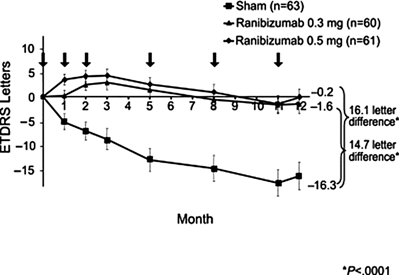
FIGURE 10.6. Ranibizumab for neovascular ARMD. Mean change from baseline visual acuity, measured as letters read on the Early Treatment of Diabetic Retinopathy Study (ETDRS) chart, at monthly intervals. At month 12, the 0.3 mg ranibizumab group and the 0.5 mg ranibizumab group differed from the sham group by 14.7 and 16.1 letters, respectively (p < 0001). The arrows indicate that ranibizumab or sham injections occurred at day 0, months 1, 2, 5, 8, and 11. (Reprinted from Regillo CD PIER Study. Am J Ophthalmol. 2008;145:2, with permission.)
Stay updated, free articles. Join our Telegram channel

Full access? Get Clinical Tree


